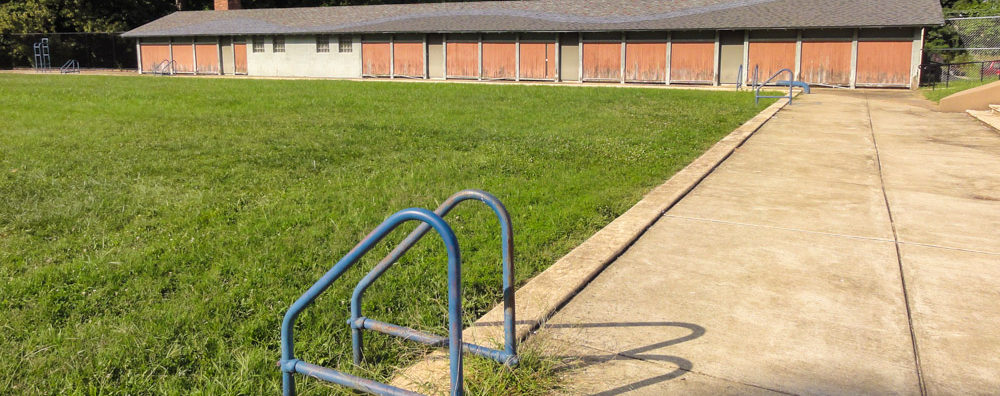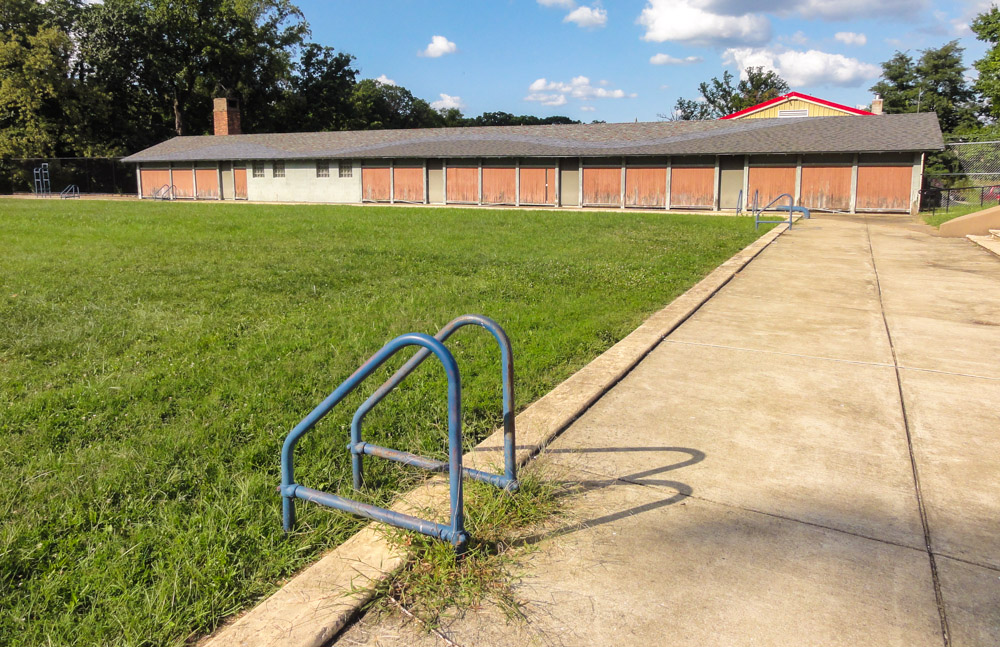
Struggle and Joy in the Druid Hill Park Memorial Pool
By Graham Coreil-Allen
Originally Published in What Weekly, January 8, 2014
Edited by Marcus Civin
I recently moved in across the street from Druid Hill Park. A friend told me about a place little-known to neighborhood outsiders—a once abandoned public pool now filled in with dirt, covered in grass and framed with sumptuous, meandering walkways designed by celebrated Baltimore artist Joyce J. Scott. Wandering through the park on a warm, sunny afternoon, I discovered the large, rectangular grassy field framed by cobalt blue ceramic tiles, expansive marble steps and forgotten structures belonging to what was once Baltimore’s only segregation era public pool for African-Americans. Long cherished by generations of residents formerly restricted to only certain park facilities, the dignified yet understated Memorial Pool remains as a landscape of memory honoring the pride and struggles of Baltimore’s black community.
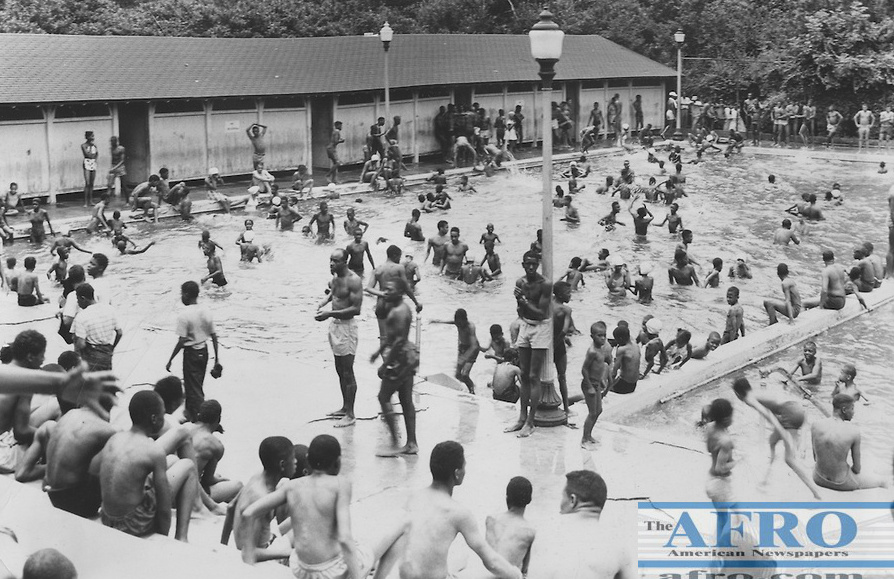
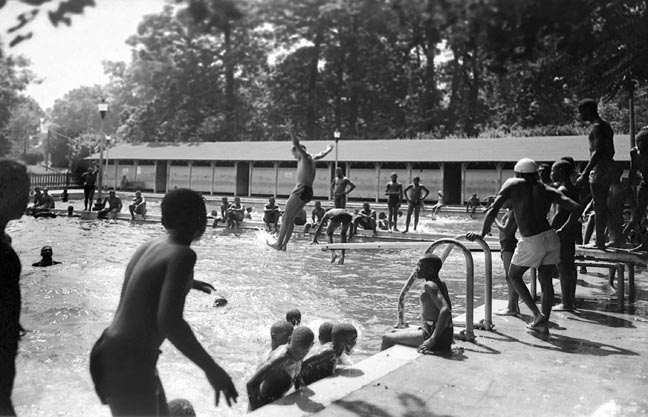
Forty years after Pool No. 2 closed, the concrete structure lay dangerously empty while the surrounding tennis courts stood in need of repair. Then, in the mid-nineties, park officials began talking with residents about what they most valued about Druid Hill Park. This was the research phase of the 1995 Druid Hill Park Master Plan. During this research phase, the planners discovered that local residents shared a strong sense of nostalgia for the historically African-American section of the park. In response, the adopted master plan called for, “a meditative, artistic, and informative setting acknowledging the segregation era at the site of the formerly “Negroe Pool”.” After a 1996 open call for proposals, Baltimore artist Joyce J. Scott was selected to redesign the pool as a place of reflection and celebration. By that point, Scott was well-known for her provocative, figurative beaded sculptures dealing with issues of race, class and gender. Growing up in Sandtown, Scott had frequented Druid Hill Park as a child and swam in the formerly whites-only pool. During an interview for this article, the artist shared with me some of her unrealized visions for the memorial design as well as her take on how the Memorial Pool’s symbolic and functional design represents the slow progress around issues of race and class in Baltimore. We also discussed the memorial as it exists today and it’s contextual surrounds in Druid Hill Park.
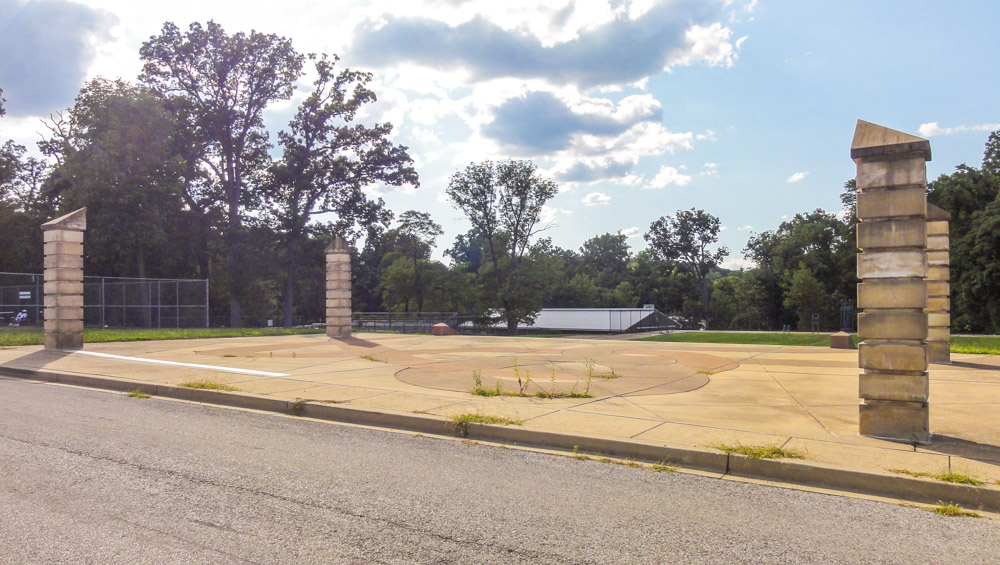

As its remains today, the now weathered Memorial Pool area continues to serve the tennis and recreational needs of hundreds of thousands of predominantly African-American park goers annually. Memorial Pool is on the southwest corner of Shop and Commissary Roads. The space is fronted by a wide, concrete pad embedded with large-scale, faded red and orange curvy concrete patterns framed by four square columns that consist of 24 inch square by 12 inch tall marble blocks stacked approximately nine feet tall and topped with diagonally sloped capitals that look like one corner of a pyramid. The chisel-topped columns suggest the outline of the old field house where pool tickets were once sold. A wide flight of marble steps leads to a 105 feet long by 100 feet wide rectangular expanse of grass resting approximately seven feet below street level.
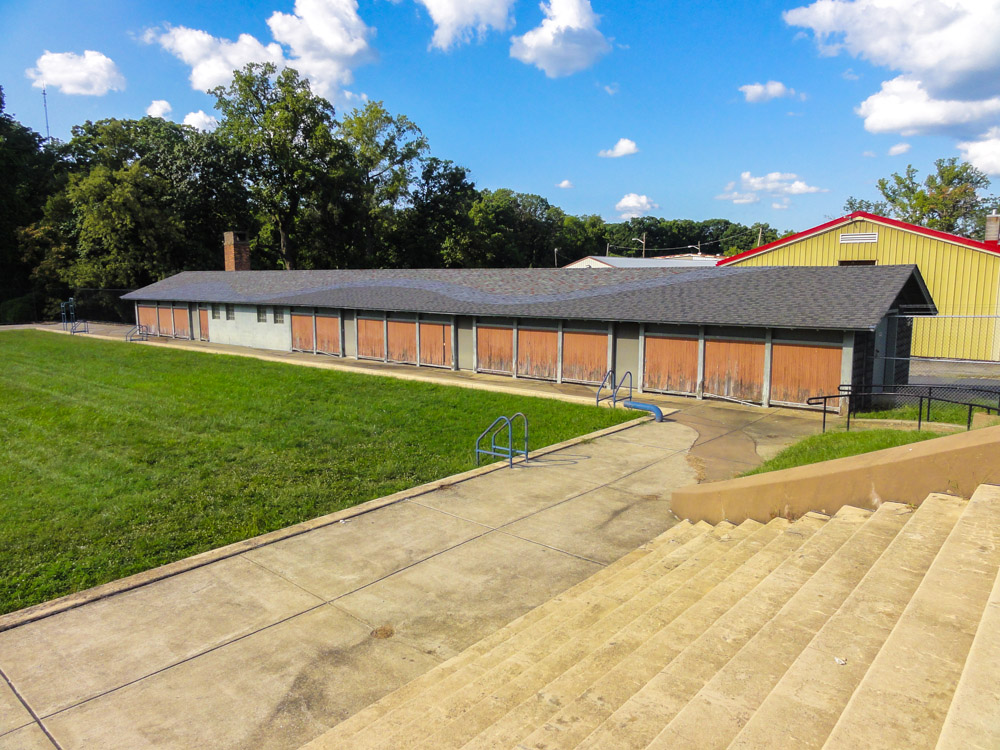
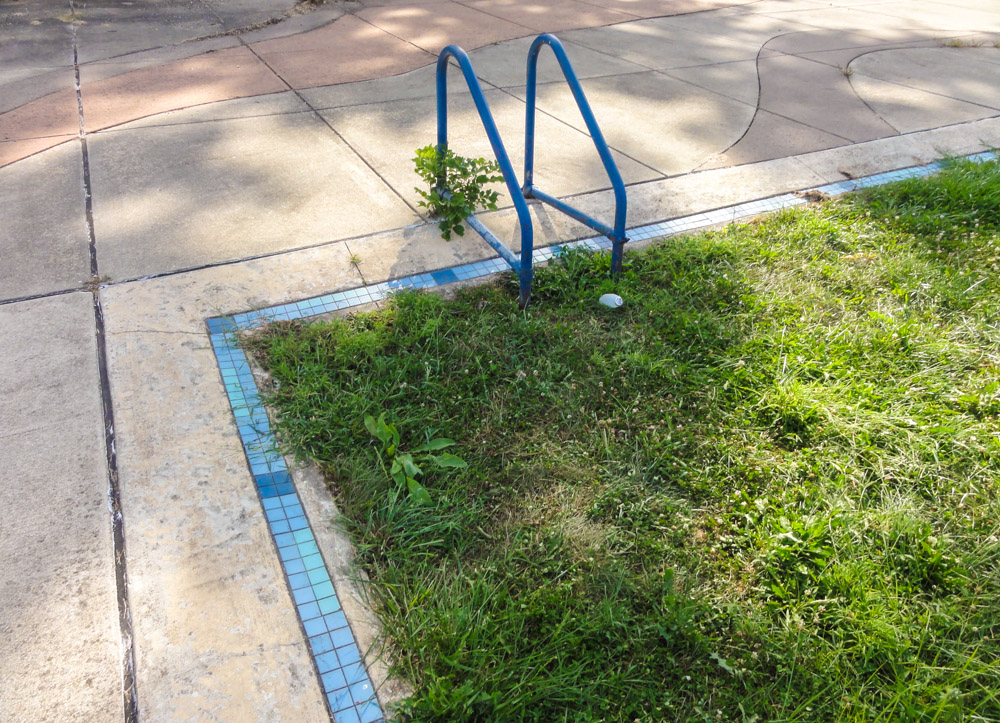
The grassy void is outlined by a thin perimeter of two rows of 2 inch square ” blue tiles surrounded by concrete sidewalks embedded with undulating patterns of orange, red and blue based on traditional African motifs representing peace, tranquility and community bonds. Around the blue perimeter tiles stand blue-painted armatures of the forlorn diving board; ladders and lifeguard stations that function as uncanny reminders of the space’s former aquatic use while also serving as skeletal sundials casting angular shadows across concrete and grass. Running parallel to the length of the pool’s north side stands a low-lying brown wooden building that used to house the men’s dressing rooms. The structure is topped with a black, pitched roof featuring a wave of blue roofing tiles symbolizing water. Around the void, the subtly colorful concrete pavement continues beyond the perimeter before turning into a meandering, southbound path accented by collections of cement-set riverstones. The river-like path connects the Memorial Pool to the nearby tennis courts, picnic grove and playground. Both ends of the path are marked with stanchions detailing the site’s rich history.

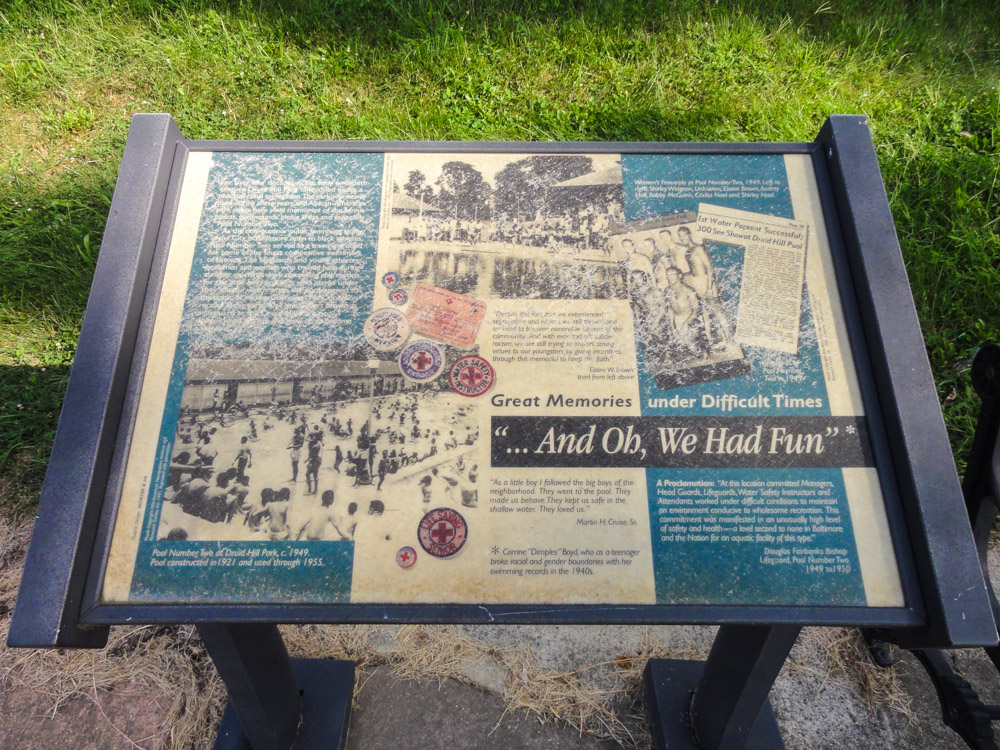
The entire site is surrounded on two sides by park maintenance facilities including loading docks, garages and trucks. On the other side of Shop Road, behind a small parking lot and two tennis courts, the historic St. Paul’s cemetery is in need of extensive restoration. The contextual contradictions and resonances of the Memorial Pool as a place of memory next to that same active loading dock and the crumbling cemetery were not lost on Joyce Scott when she approached the project in 1999. Scott first asked herself, “How do we make this area useful and beautiful, and harken back to the pool era?”
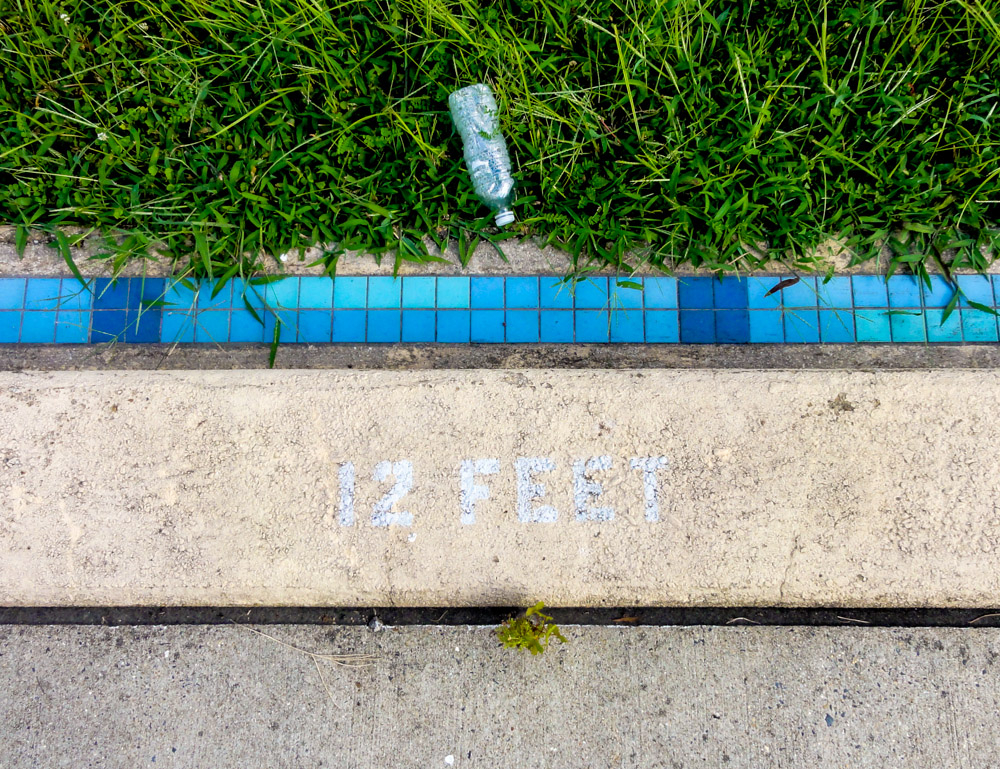
Memorial Pool, 1999, by Joyce J. Scott, photograph by Graham Coreil-Allen 130824In designing the functional monument, she states that her intent was to create an “art situation where people can go into space and hopefully be, and have a variety of uses.” Early on, there were plans to include programming in the grassy area, with the hope being that people would want to sit, picnic or just relax around the space. In addition to the architectural framing devices and aquatic symbolism, the original installation included abstract, colorful painted designs on the pavement around the pool that have since faded from the concrete surface and disappeared due to time and weather. Scott’s initial vision also included a series of metal tree sculptures embedded with clay panels and mirrors. These trees would have stood on the stony shoals of the river-like connecting path. In the end, the artist’s trees of reflection and remembrance were omitted from the plans after some members of the community expressed concern that the sculptures would have evoked lynching. While the artist strongly disagrees with this interpretation, at the time she thought it was best to acquiesce to the constituents’ concerns. By asking Scott to compromise her design, the neighbors may have unintentionally made the southern end of the memorial harder to recognize as a space of memory. In comparison to the northern end, the southern end of the memorial comes off more subtle in its overall presence, reading less like a public memorial and more like a creatively designed sidewalk with a historical marker.
For all that Pool No. 2 represents about the history of struggle over African-American access to public spaces in Baltimore, it seems inevitable that any attempt to memorialize the space would cause some controversy. But through her own vision and standing, Scott was able to effectively work with various city departments, the Maryland State Arts Council, and local community groups on creating a unique space of memory that honors the joys and struggles embedded in Druid Hill Park. The artist tells a story of how, back before desegregation, the white-only Pool No. 1 was unfiltered and connected directly to the reservoir, while the African-American Pool No. 2 was filtered in order to “de-negroize” the water to ensure the safety of the rest of the city. Inadvertently, this offensive policy resulted in a better experience for African-Americans. Scott succinctly states, “What was seen as a way of restraining someone only made them stronger.” She continues to explain that African-Americans in Baltimore responded to racist oppression by building up their own safe spaces and strong institutions. African-American strength was expressed through socializing, play and competition at the only pool offered by the city.
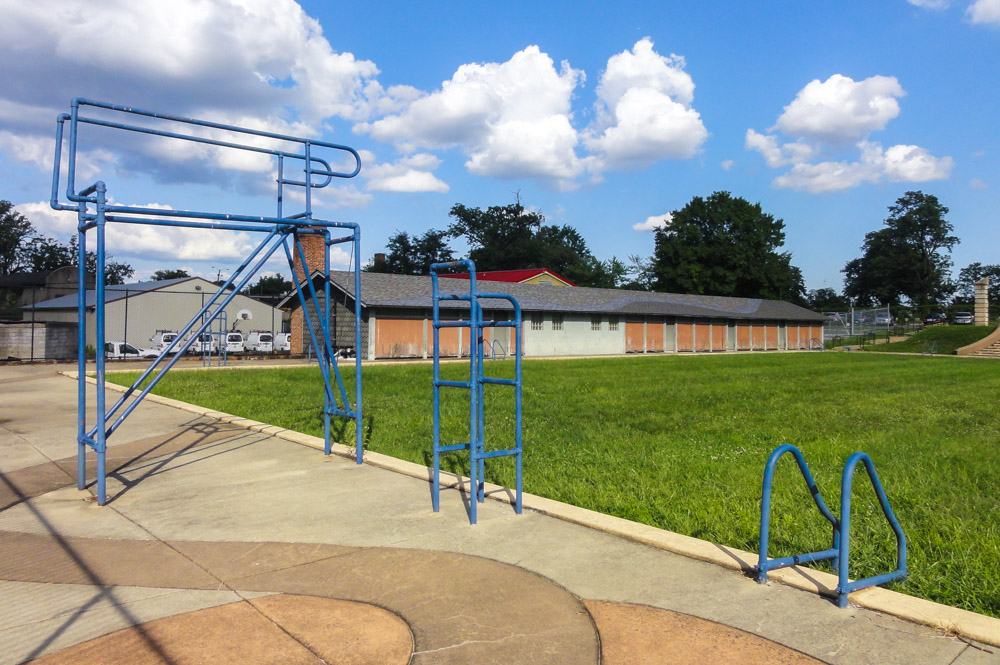
For me, the psychic presence remaining from the decades of aquatic joy and athletic gathering can no doubt be felt as I stand at the pool’s grassy, western edge, next to a diving board casting long afternoon shadows. For Scott, the Memorial Pool represents, “the sway and the slow change in our race history in our city that isn’t really that much of a change.” Indeed, as it lays today, the history, form and condition of the Memorial Pool makes a compelling, if at times concerning, analogy for Baltimore City as a whole. A brief stroll from Harbor East through the Inner Harbor and then into Lexington Market shows that while the city is much more racially integrated than it once was, it still remains intensely segregated, especially by class. Economic progress has been made in some areas while paint peels off in others. It’s through the Memorial Pool’s poignant contradictions of place and history that Scott reminds us of the inseparability between pleasure and strife. States the artist: “People have to remember that struggle and joy go hand in hand. You don’t many times understand the beauty of joy unless you go through a struggle.”


